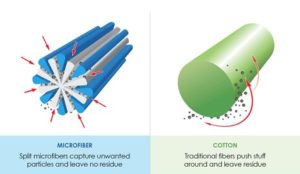New Year’s Resolution – Dry Your Car Right!
- Posted January 12th, 2021
- •
- Category: Paint Protection

How to Dry Your Car Safely
Washing your car, truck, or SUV every few weeks is recommended – regardless of where you live. But how do you dry your car safely? Some people swear by blowing standing water off with air, others use a drying aid such as a ceramic boost spray, then using a regular towel. However, using the wrong type of towel or material can be just as harmful as leaving that dirt and debris on the car’s paint job.
When you spend thousands of dollars on a paint protection solution, you want to protect that investment – right? With that said, using the right washing materials and techniques is by far, the best way to reduce developing a water spot, scratching, and improving the look of your vehicle.
The video in the car detailing and maintenance series posted on the Ceramic Pro YouTube.com channel focuses on how to dry your vehicle correctly. Whether you have a Ceramic Pro 9H coating, KAVACA PPF or the vehicle is unprotected, using a super plush microfiber drying towel is the best solution.
So – take a few minutes to watch this video by Adam Cote, as he explains why it’s crucial to end your car maintenance washes with drying it safely.
Why Should a Car Should Be Washed Every Two Weeks?
Over time, debris starts to collect on top of the vehicle surface and can cause damage to the paint, windows, plastic trim and more. Even if you have the highest quality ceramic coating or paint protection film installed, contaminants like industrial fallout, animal toxins, or other stuff can start to break down the integrity of the protective layer.
To maintain the quality of your nano ceramic coating or PPF installation, hand washing your car every two weeks using the two-bucket method is strongly suggested. The final step in this – or any type of car wash, is drying.
There are several options for drying a vehicle – but only a few that are proven to reduce scratching or damage to the surface. Some drying techniques or materials might seem safe – or have been used in the past – but can create swirl marks or etching in the clear coat or other materials on the vehicle’s exterior.
The Myths About Drying with a Chamois
If you’re an old-school car guy like me, it’s quite possible you were raised on using a sheepskin chamois as your car drying towel of choice. For those who need a refresher, a “shammy” has two qualities that makes it good for absorbing water.
First, it’s got a lot of surface area of soaking up water. This is due to having a large nap – also the material of the chamois. Most modern chamois are made from sheepskin, but there are some that are synthetic. Either way – the material is a good soaker of water. The second attribute of chamois is the ability to release water or to ‘wring it out’.
The problem is chamois essentially spreads water across the surface, but also creates suction on the paint. This eliminates the cushion – which grabs any remaining dirt, dust, or debris and etches it on the surface. This is how most scratching on a vehicle during washes occurs.
Why is Using a Squeegee a Bad Idea?
The other common method of car drying (by so-called expert detailers) is using a squeegee. This is basically the same type of product you’d use to wipe off standing water from glass or a window. While it works great on hard glass – it’s basically a scratch waiting to happen on a coated, protective film, or waxed vehicle surface.
There are multiple types of squeegees used by some car enthusiasts – but they all replicate the same potential of damage as the synthetic chamois. It creates suction to remove the water – but will also spread those damaging particles remaining on the surface. By comparison, a microfiber cloth is designed to glide over the surface and scoop up liquid. While it’s assumed you’ve removed all the dirt and debris during the wash process, there are still tiny particles remaining.
The Super Plush High GSM Microfiber Drying Towel
In the image below, you can see how the design of microfiber helps to scoop and pick-up debris vs spreading it across the surface.

Most microfiber towels are designed for detailing tasks – like removing polishing or liquid wax/spray coatings. But drying towels are much different in design. The drying towel is typically a higher GSM – or grams per square meter. This means they are heavier and can absorb more liquids. Since water is extremely ‘heavy’ – using a microfiber towel that has a GSM above 800 is strongly recommended.
You can also use a microfiber waffle weave drying towel. However, the terry weave super-plush drying towels will give you an ultra-dry car much better than a natural chamois. Whatever you do – NEVER use paper towels to dry your car.
What About Blowing Air Off the Surface?
There is another safe way of drying a car after a wash – blowing off with air. However, there is a catch. The method you use for blow drying a vehicle is extremely important to consider. Some larger detailing shops have an in-house compressor that they’ll use to blow air from those small nooks and cranny’s – like on door jams and window seals.
The problem with using air compressors is the oil inside the lines that blow onto the vehicle surface. Even shops with filters in the air lines can still contain tiny particles of lubricants that can spread on the freshly cleaned surface.
If you’re going to dry with air, use an electric-powered leaf blower. This will help blow off standing water – and allow you to use a microfiber drying towel for the final wipe down.
Still Have Questions Or Wish to Learn More about ATD Detailing?
If you’re thinking about having a professional detailer such as, ATD Detailing, install Ceramic Pro 9H coatings to the inside or outside of your vehicle, or Paint Protection Film – click here to request a free estimate.